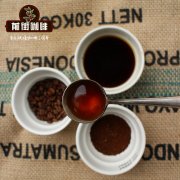Panama coffee beans produce what is good Panama Geisha coffee king

Professional coffee knowledge exchange more coffee bean information please follow the coffee workshop (Wechat official account cafe_style)
Front Street-Panamanian Coffee introduction
Panama is a small country located in the center of the American continent, with a total area of 75517 square kilometers. It is bounded by Colombia to the east, the Pacific Ocean to the south, Costa Rica to the west and the Caribbean to the north. The country connects North and South America in the shape of "S". There are ups and downs and valleys throughout Panama. There are many rivers. Except for the north-south coastal plain, it is mostly mountainous.
Panama is near the equator and has a tropical maritime climate. It is humid during the day and cool at night. The annual average temperature is 23-27C °. The whole year is divided into two seasons of drought and rain, with an average annual precipitation of 1500mm to 2500mm.
The finest coffee in Panama (Panama) is grown in the west of the country, near Costa Rica and the Pacific Ocean. The Boquet district of Chiriqui province is the most famous for its coffee, as well as Wakan, Santa Clara and Kendra. Other areas include David, Remacimeinto, Bugaba and Tole. Only coffee grown at elevations between 1300 and 1500 meters above sea level is considered special coffee.
The BOQUETE region of Panama, located in the province of CHIRIQUI on the border with Costa Rica, is home to Panama's famous GEISHA coffee and is famous for producing high-quality Arabica coffee.
The production of Panamanian coffee has been declining in the past few years. However, the mild taste, high sweetness and nutty taste of Panamanian coffee have always attracted coffee fans, especially the discovery of the coffee variety Geisha (geisha or Rosa). Since the beginning of the 21st century, "Panama" and "geisha" have almost become synonyms. A species of geisha was found at the famous Hacienda La Esmeralda estate (Peterson family property) in Boquete, Panama. In 2004, the Petersons picked the geisha separately from the farm and took them to win the annual competition for the best coffee in Panama.
Geisha soon caught the attention of the boutique coffee world, with raw geisha beans at Esmeralda Manor fetching more than $140 a pound at auction. The success of geisha at auction has led to the emergence of geisha on farms that used to grow only Kaddura and Bourbon. Even other coffee-producing countries have grown geisha, such as Colombia, Guatemala, Costa Rica and so on.
Knowledge: Panama has one of the highest volcanoes in Central America: Mount Baru. The Baru volcano has an altitude of more than 3474 meters, and the surrounding land is nutritious and balanced, providing sufficient conditions for the sowing and cultivation of Panamanian coffee.
In short: Qianjie is a coffee research hall, happy to share the knowledge about coffee with you, we share unreservedly just to make more friends fall in love with coffee, and there will be three low-discount coffee activities every month. The reason is that Qianjie wants to make more friends drink the best coffee at the lowest price, which has been Qianjie's tenet for 6 years!
END
Important Notice :
前街咖啡 FrontStreet Coffee has moved to new addredd:
FrontStreet Coffee Address: 315,Donghua East Road,GuangZhou
Tel:020 38364473
- Prev

Do coffee beans taste chocolate? Colombian coffee satisfies your wish.
Professional coffee knowledge exchange more coffee bean information please follow the coffee workshop (Wechat official account cafe_style) front street-Colombian coffee introduction Colombian coffee has always been our favorite when you are in the coffee plantation in Narino, you can't help but think of Colombian coffee, when you drive through the steep and muddy mountain road, there are steep peaks on one side and the other.
- Next

What is the grade of Rosa Coffee? it is necessary to know the brand of Panamanian Rosa Coffee.
Professional coffee knowledge exchange more coffee bean information please follow the coffee workshop (Wechat official account cafe_style) front street-Emerald Manor Rose Summer introduction until the Panamanian Emerald Manor (Panama La Esmeralda) owner DanielPeterson, accidentally found in the top of their coffee estate, these were originally used as a windbreak geisha coffee trees produced coffee beans
Related
- Beginners will see the "Coffee pull flower" guide!
- What is the difference between ice blog purified milk and ordinary milk coffee?
- Why is the Philippines the largest producer of crops in Liberia?
- For coffee extraction, should the fine powder be retained?
- How does extracted espresso fill pressed powder? How much strength does it take to press the powder?
- How to make jasmine cold extract coffee? Is the jasmine + latte good?
- Will this little toy really make the coffee taste better? How does Lily Drip affect coffee extraction?
- Will the action of slapping the filter cup also affect coffee extraction?
- What's the difference between powder-to-water ratio and powder-to-liquid ratio?
- What is the Ethiopian local species? What does it have to do with Heirloom native species?

